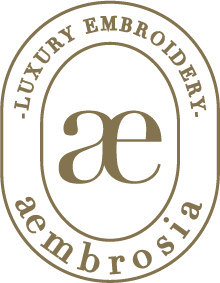What is goldwork embroidery?
A photo of a catholic liturgical vestment from my visit to the exhibition “Tra la terra e il cielo-I meravigliosi ricami delle Orsoline”, Gorizia, 2023.
Goldwork embroidery is a set of techniques more than two thousand years old, used to adorn the clothes and interiors of emperors, kings and religious leaders. Wherever an image of power and magnificence was wanted, goldwork embroidery was present.
The tradition of this technique has evolved and changed over the millennia, and also changes from one country to another.
Strong traditions have survived in Europe, linked to religion in Spain and linked to the royal house in England; in France and other countries there is a production for the ranks of military and law enforcements, and there are also strong traditions in Arabia and in Asia.
The most typical material for gold embroidery is 24 kt gold-plated metal, with a deposit equal to gold-plated jewellery, from 2.5 to 5 thousandths. Silver or copper is also widely used. Today there is also material for gold embroidery in a non-precious version, which can be artificially colored in every shade of the rainbow.
Coronation Robe of Queen Elizabeth II, Photo credits by Royal Collection Trust
Given the value of the craftsmanship and the rarity of this technique, Aembrosia prefers to use only precious metals (24 kt gold, or silver), to enhance the value of the product, which becomes a real jewel.
We can call it goldwork embroidery when there is the use of metallic material placed on the right side of a fabric, fixed with a cotton thread. In fact, the precious material must not be wasted, and many types of stitches and methods have been created to embroider metal and create different effects; up to even very sculptural and spectacular results, thanks to the use of padding.
Gold embroidery is a technique that differs greatly from the most-known classic embroidery (stem stitch, satin stitch, etc.). In Italy, the number of people capable of carrying out this technique in a complete and professional way, can be counted on the fingers of one hand.
Detail of Aembrosia’s bee - work in progress. Ph credits Silvia Marabese
Precisely to avoid the disappearing of this technique, Aembrosia creates precious accessories that can reinterpret it in a contemporary way. The technique must evolve and find new applications, in order to carry on the human ability to express beauty and art through the work of the hands.
To create spectacular pieces, Aembrosia often mixes gold embroidery with other Haute Couture embroidery techniques, such as Lunéville crochet embroidery or needlepoint application of crystals and beads.
Cos’è il ricamo in oro?
Papa Giovanni Paolo II diventa Papa: il ricamo in oro è sempre presente in occasione dei più importanti eventi ufficiali. Photo credits by Rai Cultura
Il ricamo in oro è un insieme di tecniche utilizzato da più di duemila anni, per adornare abiti e arredamenti di imperatori, re e capi religiosi. Dovunque si voleva trasmettere un’immagine di potere e magnificenza, il ricamo in oro era presente.
La tradizione di questa tecnica è evoluta e cambiata nei millenni, e cambia molto anche in base alla zona geografica. Sono sopravvissute forti tradizioni in Europa, legate alla religione in Spagna e legate alla casata reale in Inghilterra; in Francia e in altri paesi esiste una produzione per i ranghi di militari e forze dell’ordine, e ci sono forti tradizioni anche in Arabia, in Asia centrale e in estremo oriente.
Il materiale più tipico del ricamo in oro è metallo bagnato in oro 24 kt, con un deposito pari a quello della gioielleria bagnata in oro, dai 2,5 ai 5 millesimi. Molto utilizzato è anche l’argento, oppure il rame. Oggi esiste anche materiale per il ricamo in oro in una versione non preziosa, colorabile in modo artificiale di ogni sfumatura dell’arcobaleno.
Vista la preziosità dell’artigianalità e della rarità di questa tecnica, Aembrosia preferisce utilizzare solo metalli preziosi (oro 24 kt, o argento), per esaltare il valore del prodotto, che diventa a tutti gli effetti un gioiello.
Work in progress dell foglie ricamate in oro di Aembrosia.
Si parla di ricamo in oro quando c’è l’utilizzo di materiale metallico posato sul diritto di un tessuto, e fissato con un filo di cotone. Infatti, il materiale prezioso non deve essere sprecato, e sono stati creati tanti tipi di punti e metodi per ricamare il metallo e creare effetti diversi; fino ad arrivare anche ad effetti molto scultorei e spettacolari, grazie all’uso di imbottiture.
Il ricamo in oro è una tecnica che differisce molto dal ricamo classico più conosciuto (punto erba, punto pieno, etc). In Italia le persone in grado di svolgere questa tecnica in modo completo e professionale si contano sulle dita di una mano.
Proprio per non far scomparire questa tecnica magnifica, Aembrosia propone accessori gioiello che possano reinterpretarla in modo contemporaneo. La tecnica deve evolversi e trovare nuove applicazioni, per poter portare avanti la capacità umana di esprimere bellezza e arte attraverso il lavoro delle mani.
Per creare pezzi spettacolari, spesso Aembrosia mischia il ricamo in oro con altre tecniche del ricamo d’alta moda, come ad esempio il ricamo a Crochet di Lunéville o l’applicazione ad ago di cristalli e perline.











